(Guest Post)
By Robert Gulley K4PKM
(Note: This review was requested by Radioddity, who provided the in-production radio to the reviewer, with no strings attached or pre-approval.)
I confess to have been a little bit skeptical when Thomas asked me to review this radio, not because of past experience with RADDY, but because tiny radios in general don’t usually impress me, and I have had plenty of them over the years and considered most of them a novelty. There are a few exceptions, of course, such as the C.Crane Skywave or the Tecsun PL-368, but for the most part there are simply too many limitations to tiny radios for my listening style (this one can literally fit in a shirt pocket!). Upon opening the box I was still skeptical, despite the rather impressive packaging and extras. But hey, a little skepticism is a good thing, right?!
Accessories
The radio comes with a thin carry case to protect it from scratches, a rechargeable lithium battery, strap, earbuds and a wire antenna to improve shortwave reception. There is also a Type “C” USB cable for charging the battery. Oh, and a spare set of earbud covers – a nice touch!
Ergonomics
Picking up the radio I noticed right away it has a solid, comfortable feel to the unit. I start with that because most tiny radios feel very flimsy, and usually have something of a rough or hard plastic feel to them. This radio has a glossy feel to it, meaning it is comfortable and actually nice looking. Looks aside, I must admit the ergonomics of the radio impress me. I like the feel of it in my hand, and the controls are laid out well for one-handed operation. Being left-handed, that is not always the case, but the controls seem well thought out for either right- or left-handed folks.
As you can see in the images there are two primary rows of buttons, as well as a tuning knob on the right side of the radio. There is also a belt clip on the back which is unobtrusive – I can’t speak to its longevity as I really never clip a radio to my belt, but for those who do, I suspect it will hold up well with a little care.
The telescopic antenna (fixed) is rather impressive as well, measuring ~18 inches in height when fully extended. As one might imagine, at this length the antenna is fairly fragile – I would not walk around with it fully extended while attached to my belt. For hand-holding it should be just fine, and standing upright on a table it does not tip over, but if out in an open-air environment with a strong breeze it will tip over, so a stand would be advisable.
The display is very readable, and the orange background light which pops on when making adjustments is quite nice. The light stays on for ~9 seconds after pushing any of the buttons. Another nice feature of the radio is a press of any button while the radio is off will turn on the display, indicating time, temperature, and battery strength. Yes, it has a built-in thermometer, and it seems quite accurate, at least on the unit I received.
On top there is an external antenna jack, headphone jack, and slot for the strap.
Operation
For such a small radio it is literally packed with features. I will not go over all of them in this review, but I will cover some of the highlights as well as make mention of most features at least in passing. I was not expecting so many features in this little radio, so I was pleasantly surprised by some of the more advanced options.
Naturally the radio has AM/FM capabilities, as well as weather, air, VHF above the air band, SW and CB (yes, CB!). There is also a customizable frequency range setting for monitoring a desired set of user-selected frequencies. There are presets available for various modes listed in the manual, including predefined amateur radio bands and shortwave stations (always subject to change, of course!).
There is an attenuate function available if needed, as well as numerous step modes for tuning various modes. One interesting feature of the radio is two separate tuning methods, one by up and down buttons, and the other by a tuning knob on the side. These can be set independently of each other in terms of the step-change on a given band. This is particularly useful when scanning a band with the buttons after a station is found, because sometimes being slightly off frequency can produce a better signal – the scroll wheel can be used to make as little as 1 Hz changes.
Finally, there is a very useful bandwidth feature which can change between 3, 2.5, 2, 1.8, 1, and 6 kHz. Tuning is quite functional both with the scroll wheel and the tuning buttons. Holding down the tuning buttons will start a scan of the current band, and a longer press will speed up the scan if no stations are found initially. Unlike some scanning radios, when a signal is found, scanning stops and does not resume. I like that feature better than the alternative method of some radios restarting a scan after 5 seconds or similar. I want time to figure out what I am hearing, and a short stop does not really allow for that most of the time.
Reception
I have to say I am impressed with this little radio. I have listened to amateur frequencies, shortwave frequencies, AM/FM, weather and tried airband (nothing close to me except a minor airfield). I live in a very quiet location in terms of local man-made interference, and this provides a great opportunity to really test out a radio’s sensitivity. My conclusion may surprise you as it did me. This is one sensitive radio, given its small form factor and limited antenna movement. (I did not test the external antenna option. While it has one, I felt it only fair to make tests using the built-in antenna on all the radios I compared it with, thus eliminating extraneous or otherwise hard to compare situations.)
Side by side with one of my favorite portables, the Sangean ATS-909X2, this little guy was right in there with difficult to receive stations. While the Sangean has a much larger speaker and therefore fuller sound, in terms of actual reception, most stations came in about equally. I even used an old, but very reliable Select-A-Tenna to boost AM reception on both radios, assuming the Sangean has a much larger ferrite rod given its size, and yet both performed equally well next to the passive antenna. Impressive!
On various shortwave and amateur stations the RADDY RF760 held its own again, picking up almost station for station what the Sangean and the Sony 7600 GR (another favorite of mine) did, in a package less than 1/3 the size of the Sony, and about ¼ the size of the Sangean. Am I going to dump my Sony and/or my Sangean? Of course not – there are many reasons I prefer those radios for my daily use. But if I were wanting to go extremely lightweight/portable, the RADDY is a keeper with impressive performance and most features one could want in a portable radio, all while still fitting in your shirt pocket. I truly do not know how one could get much better performance or features in another radio this size. It makes one wonder where can they go from here?
FM reception is also quite good, pulling in weaker stations while still being quite listenable. I have heard a few stations on this radio which I have not caught before, and this with some atmospheric noise due to storms in the region. Likewise, listening to AM while there were storms in the general area, still allowed for reasonable reception. As we all know AM broadcasts are highly susceptible to atmospheric noise, especially lightning, but this radio recovered nicely after each static crash. Some radios seem to linger longer in recovery after such events, but this radio was quick to bring back in the signals.
Negatives
In short, there really are not any glaring negatives to this radio, so allow me to point out some little things which are, after all more about personal preference than any deficiency in the radio. Your mileage may vary, as they say.
- An articulating antenna would be a nice touch, but that might require an increase in size, and likely would make the antenna more susceptible to damage. Many times, being able to bend an antenna this way or that can improve a signal.
- Changing the frequency steps can be a little fiddly at times, but that’s probably me
- When powering on, the short press acts like pressing any other button, meaning the light comes on, the time, temp, and battery power indicator displays. A longer press brings up the sleep timer. Two short presses turns on the radio, but not too short of presses. This takes a little getting used to, and I would prefer one longer press to turn on the radio, with the two short presses activating the sleep timer, but that, I know, is getting really nit-picky!
Conclusion
If you are in the market for a small, lightweight, but solid radio – this RF760 is definitely one you should consider. It is so light as to be almost weightless, compact but with easily reachable and useful controls, and has more modes and features than almost any similar radio I have run across. As an old-timer I have to shake my head in amazement at what can be packed into such a small radio these days! This certainly isn’t your grandpa’s transistor radio (and it’s even smaller!). Cheers!

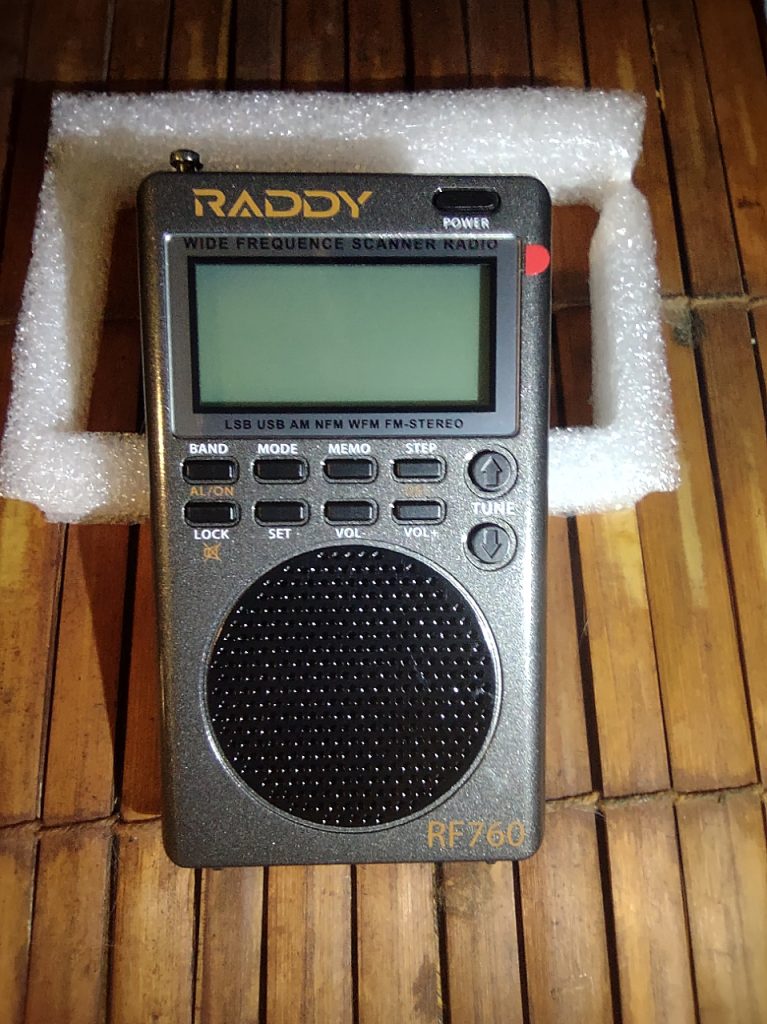
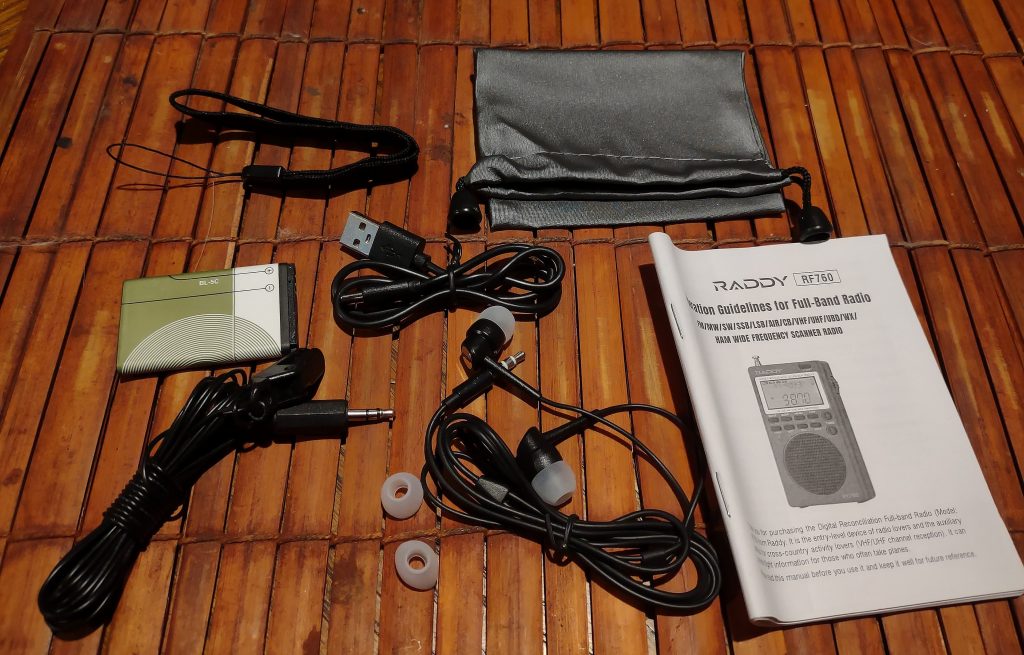
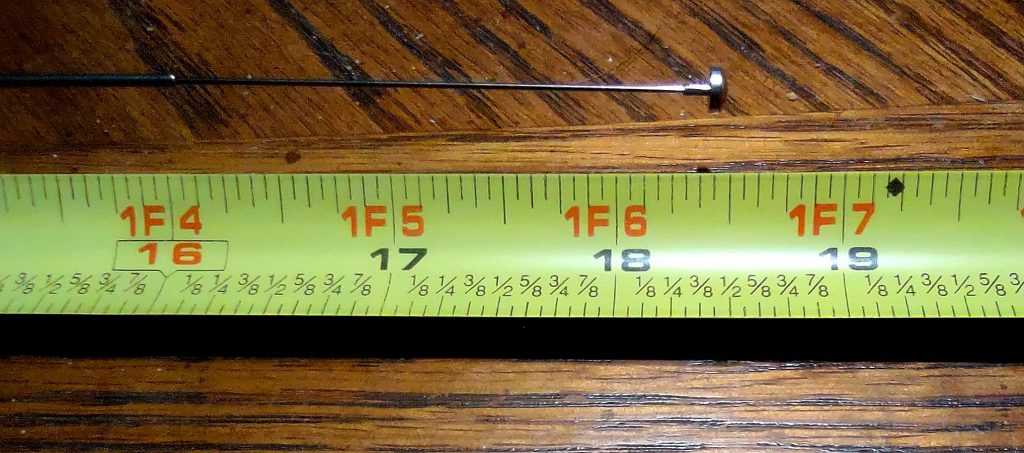
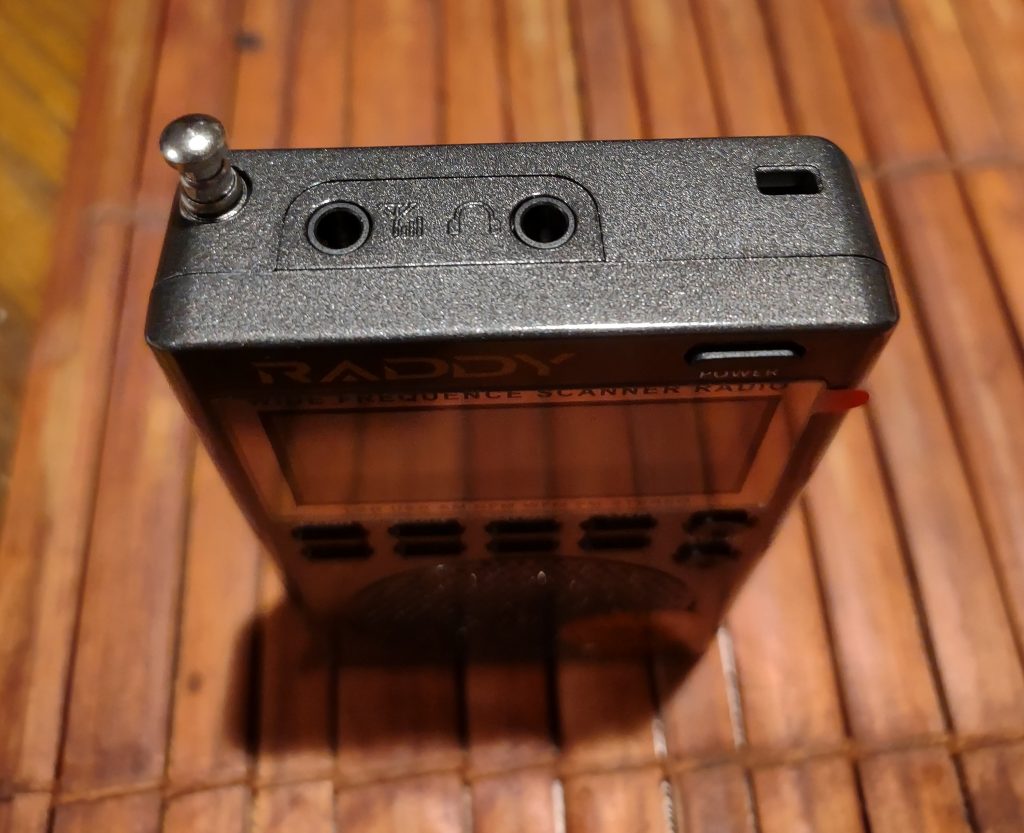
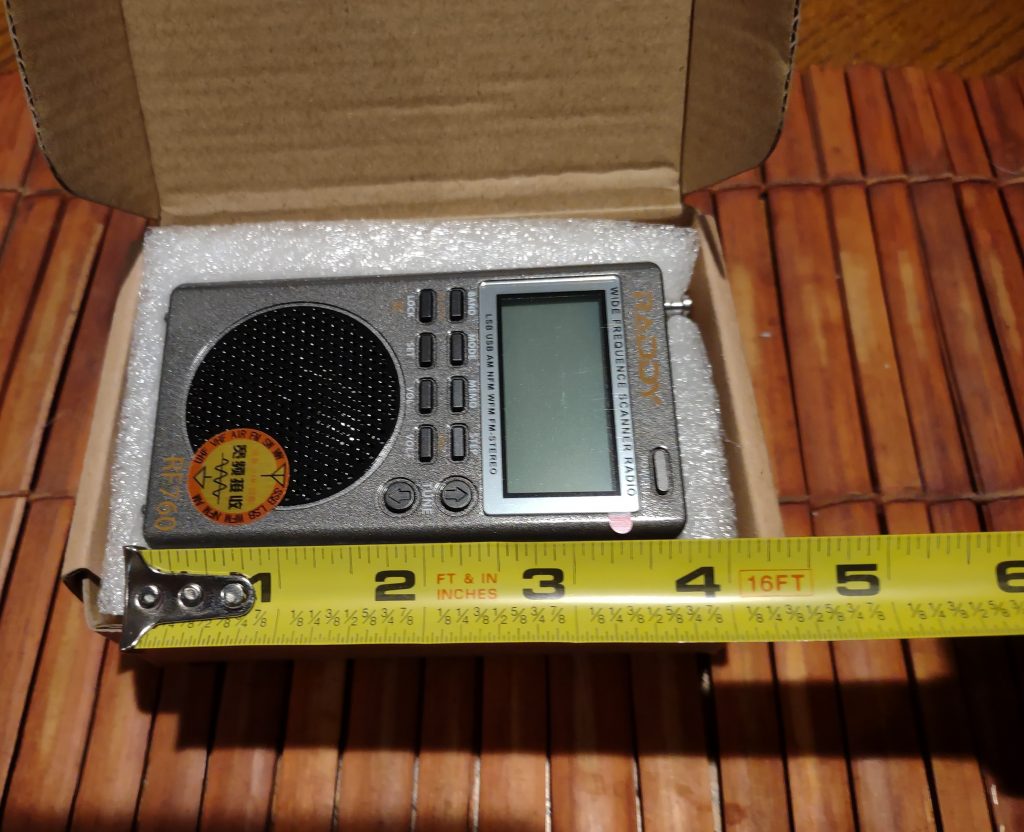
I purchased the Raddy RF-760 just about one year ago. At that time the price was still high, at 1¢ short of $100 USD. The performance was lacking for a $100 portable. In particular connecting to any length outdoor antenna resulted in severe overload. I do live in a major metropolis, so the ether is filled with high-powered commercial broadcasters. I returned it and purchased a Tecsun PL-330. Now a year later the Retekess TR-110 is closing out at $50 USD. The TR-110 is identical to the Raddy RF-760. At the lower price point the little set is ideal for using outdoors with its (flimsy) telescoping antenna. It’s very sensitive and I receive, in my concrete walled apartment building, many signals. The signals include weak semi-local AM, distant FM, and local VHF State Troopers. At the new price point I recommend this diminutive radio. It’s perfect for listening during my daily walks through our neighborhood.
And I will add, when I returned the original RF-760, along with a 1-star Amazon Review, Radioddity contacted me multiple times. They do have excellent customer service and strive to make their customers experience a positive one. They continued to offer me discounts, but they were not that significant. I’ve found that Chinese companies are pretty tight with the purse strings. Unlike American counterparts. While working at American corporations (HP, Tektronix, Circuit City, Lowe’s) we literally gave thousands of dollars away for customer service issues.
Total piece of junk. Not even usable. I will continue with my sangean.
I,to, have the Raddy RF760, and have been impressed by all the functions available in this tiny (comparably) shirt pocket radio. While I’ll say the reception is good, being in an area location where there is quite a bit of QRM, (RF interference) it is not the best likely due to its small stature and interior components. I’ve been listening to SW since childhood via various old SW radios (the venerable Grundig 750, yachtboy, and globe traveler, Sony, Hallicrafter, Realistic, Sanyo, etc, thanks to my grandfathers collection. The originated reviewer mentions fiddly freq steps occasionally, and I agree. (I’m not really a reviewer as I’ve never complained or praised product until I started spending hard earned dollars and that mentality of “you get what you pay for.” This little radio has become a favorite due to its various extras like the CB, V/UHF, as example, but also more due it’s tiny size. Speaker size could be a bit of contention, but again, for its size, good little thing. The antenna definitely needs to be a little more robust if you’re an out in the field type of listener, but with a little care it’ll do. Overall not bad as radios go, and if you’re looking for ultra lightweight and ease of function… definitely a competitive choice to which I’d recommend!
I only miss the ability to scan my stored frequencies
Have to laugh at the text on the front “WIDE FREQUENCE SCANNER RADIO”, that telescopic antenna looks like it will snap after being pulled up and down a few times. I don’t have one so guess I can’t really comment but it looks pretty cheap and nasty to me. The Tecsun radios are examples of Chinese stuff that is as good quality as anything else around, this however looks like junk to me.
I have several of this brand of radio. They are all exceptional quality and have never given me an ounce of problems and do what they are supposed to do. I can’t believe they sell them at the price point they are for the quality you receive.
Looks like the one I need to replace the units of the last century!
I have the HRD747, which apparently is the same radio. I must admit that I have found the HRD747 to have some significant deficiencies. The ergonomics are poor and sometimes counterintuitive (e.g. “mode” button functions as a band switch). Some of the text on the display is almost microscopic. WRT reception with this little radio, the SSB is quite poor. On my unit, it seemed impossible to get a proper fix that produced a natural sound, despite the very fine tuning increments. Also, there seemed to be no discernible difference when switching through the different bandwidth filter settings (at least in SSB mode; I didn’t try switching bandwidths in AM mode).
For MW/SW listening, the similarly priced Tecsun PL368 is a superior alternative to the HRD-747. Both sport a handheld type of configuration. However, while the HRD-747 might have the advantage of a smaller footprint, the PL368 runs circles around the HRD-747 in terms of MW and SW performance.
Hopefully those behind the HRD-747 continue to move forward evolving the concept, since the idea of a feature-laden pocket-sized multi-band portable is quite appealing for obvious reasons. But as for the HRD-747, sorry, no cigar…and not even close.
“It makes one wonder where can they go from here?” Well, obviously that would be DIGITAL! I was surprised, on a new radio, not to see any DAB/HD/DRM capability.
Robert,
As they used to say on Laugh-In, “Verrrrry interesting!”
Thanks for the review.
Cheers, Jock
Ah, methinks you are a fellow old-timer!
If this has the same linit8 as the 747, then there’s no difference.
Living in a metric country it is the first time I have seen a tape measure with fractions on it.
Mangosman
Is this the same radio as the HRD-747?
It is. I have both. They are the same.
No, this is a different radio. Cheers!
AFAICT, they are branded models of the same receiver. 😉 Same case. Same display. Same features. Same battery. About the only obvious difference is the HRD-747 can be sourced for a few dollars less than the RF760.
Hi –
Looks like my mistake – I had not heard of the HRD-747 (or at least didn’t remember it) and when I typed it in for a search I must have typed something wrong because I got a different radio – doing the search again brought up a radio that looks basically identical, so sorry for the confusion (on my part!)
Cheers!
Does it do SSB and have RX filter bandwidth selections?
Yes, both SSB and bandwidth selections. Cheers!